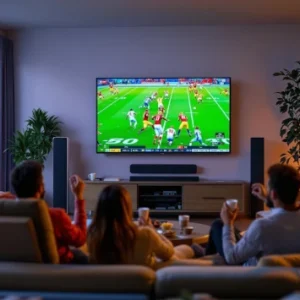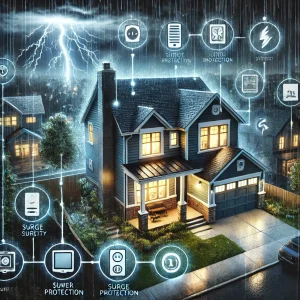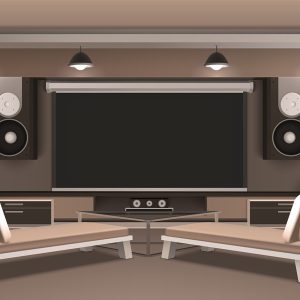
How to Design a Home Theater
A home theater can raise the house’s value and provide a place for entertaining family and friends. However, there are many options when selecting your home theater’s tools, furniture, and design. For example, do you want a simple audio setup or a Dolby Atmos arrangement? These choices and others will impact your budget and the caliber of your viewing experience.
Ambrosic Home Theater Designs, LLC offers home theater design, installation, and seating of home theaters. We have years of experience designing unique and helpful home theaters that will provide you and your family countless hours of cozy and fashionable entertainment. So let your incredible home theater come alive with Ambrosic Home Theater Designs, LLC. Contact us today to start your dream home theater!
How to Design a Home Theater
Here are some steps to help you design a home theater for the perfect movie night:
Ask Yourself Why You Need A Home Theater
Why I need a home theater is the first and most important question you need to ask yourself. Your journey will be facilitated by knowing the answer to this query because you want to be someone other than the person who spends a lot of money on a home theater system only to use it sometimes. Additionally, this will solve many design-related questions and provide clear guidance on selecting the right audio and video systems, including the right movie screen.
Location of the Home Theater
For a home theater enthusiast, one crucial element that requires the most attention is where you should put your home theater. Create an idealized audience first. Its location will be based on the audience type. The official audience won’t need to invade your personal space. Thus the home theater can be situated closer to the common areas without causing a disturbance.
Your incredible home theater set-up must serve as a private room for a casual and up-close audience, designating its location on the interior part of the home away from the public spaces. To minimize noise on both sides, it is also essential to locate the home theater away from the house’s high-traffic areas.
Color Scheme of the Room
The dark color scheme will enhance your home theater experience. A dark theme will enhance the atmosphere. The optimum color scheme will be monochrome black since it will reduce the amount of light reflected from the surface and because a small amount of light entering the home theater won’t significantly impact the people.
One of the most popular color patterns for home theaters and similar rooms is dual chrome, which consists of black and its substitute color. Use up to three colors in any situation. Simple color schemes that capture attention are for the audio and video systems.

Plan for Proper Seating and Viewing
Even if you install the best audio-video equipment on the market, the room’s atmosphere may be better if the design is good and the occupants are given the best possible seating and views. Consider that the screen should be at the eye level of the viewer for the optimum watching experience.
To plan the layout and seating, you must first determine the number of people who will fit in the space at most. Also, factor in the eye level of the people seated. Make sure you don’t cut any corners when it comes to seating because doing so will have a terrible effect on the audience. To enable the people to have a very informal and happy atmosphere, flexible seating that allows for more postures must be favored over rigid seating.
Limit Reflecting Objects
If you want to enjoy a movie theater experience in the comfort of your home, you need everything to be just as good as it is in a theater. If you don’t pay attention to every detail, any obstruction will make the experience less enjoyable overall.
For your dedicated home theater room experience, eliminate all big and small distractions to make your movie-watching session fantastic. One of them is reflected light, and one of the best ways to stop it is to cover exposed surfaces like walls with non-reflective materials.
Control the Environment's Ambient Lighting
You may add ambient lights to your home theater accessory list to maximize your movie-watching experience. Different movie genres and lighting styles evoke various emotions.
A multicolor ambient light you can control is necessary if you want to avoid keeping up with a boring movie genre. In addition, it can help you feel more in the mood for the movie you’re watching. Select a light source that allows you to adjust the light’s intensity to suit your needs; otherwise, the extreme light intensity will impair your experience.

Acoustic and Sound Properties
The interior and exterior of the home theater must be separated acoustically. Acoustic treatment is key to the best home theater experience. There are two factors at play. First, you won’t want outside noise to distract you from or damage your movie; second, guests outside the home theater will only want to hear the sound of your movie. Installing or using sound-absorbing materials inside the home theater is necessary to strike a balance between the two to make your audio experience more complete. Installing a proper sound system is also crucial. Scout around for the best component home theater systems. A Dolby Atmos setup is perhaps one of the most popular sound setups.
Daylighting and Ventilation
For the areas in your home, ventilation, and daylighting may seem like a prerequisite, but home theaters require a little different maintenance. Any natural ventilation design feature may encourage a lot of noise disruption.
You would want to avoid daylight in your home theater since it would divert your attention away from the screen. As a result, mechanical ventilation systems must be set up, and outdoor lighting should be minimal. Use a quality HVAC (heat, ventilation, and air conditioning) system without hesitation.

Selection of Audio/Video Systems
The choice of audio and visual system installation is crucial in ensuring the optimum output from your home theater. It is both one of the most complex decisions to make and one of the most important.
Prioritize the movie genres you enjoy most and the potential genres you intend to watch in your home theater before searching the market for the best system that best meets your needs. It will help you make an informed choice.
Keep It Simple
It is a common belief among people to show off rather than have better comfort, which is the issue. People frequently want their home theaters to be extraordinarily flashy and funky. A quirky design would divert your focus from the film, and eventually, your enjoyment of the film would deteriorate. Look for a simple, minimalistic design style, at least for your home theaters, to assist you in avoiding this problem and increase your enjoyment of the film.
Frequently Asked Questions
What Comprises A Component Home Theater System?
A video display (such as a regular TV, plasma or LCD TV, a projector, etc.), a surround sound A/V receiver, and a video source is the most fundamental parts of a home theater system (DVD or Blu-ray player, cable or satellite box).
What is Theatre Design Concept?
A theater design concept thoroughly explains the production’s overall audiovisual experience. It combines theatrical design elements (scenery, lighting, costumes, make-up, sound, and graphics) to communicate meaning to an audience.
What is the Importance of Theatre Design?
The main goal of theatre design is to improve the viewing experience for the audience. For all your home theater design and installation services, contact Ambrosic Home Theater Designs, LLC.
Home Theater And Smart Home Experts
Home theater design can be challenging, but with the help of an expert like Ambrosic Home Theater Designs, LLC, it can be straightforward and enjoyable. We have years of experience designing home entertainment systems that meet our customer’s needs and tastes. From consultation to the final installation, we will collaborate with you to ensure your absolute pleasure. If you wish to ask about our services or want to schedule a free consultation, contact us today!




